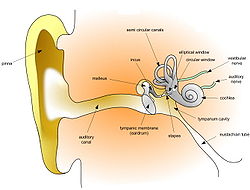Ear
Appearance
- For alternative meanings, see ear (disambiguation).
An ear is an organ used by an animal to detect sound waves. The term may refer to the entire system responsible for collection and early processing of sound (the beginning of the auditory system), or merely the externally-visible part. Not all animals have ears in the same part of the body. Audation is the scientific name for the sence of hearing. The organ of Corti is the actual organ of hearing.
The mammalian ear

Mammals, including humans, have two ears, one on each side of the head.
- The outer ear is the external portion of the ear and includes the eardrum.
- The middle ear includes the ossicles (three tiny bones), two muscle tendons (of the stapedius and tensor tympani muscles), and two nerve bundles (the horizontal portion of the facial nerve and a branch of the facial nerve called the chorda tympani). The Eustachian tube connects from the chamber of the middle ear to the back of the pharynx to equalize the pressure. That's why you can feel your ears "pop" when descending on an airplane
- The inner ear comprises both the organ of hearing (the cochlea) and the labyrinth or vestibular apparatus, the organ of balance located in the inner ear that consists of three semicircular canals and the vestibule. Within the cochlea are located three canals: the tympanic canal, the vestibular canal, and the middle canal.
Non-mammalian hearing organs
This section needs expansion. You can help by making an edit requestadding to it . |
Spiders have hairs on their legs which are used for detecting sound.
Reptilian ears only have one bone — the columella (stapes) (see below).
See also
- WikiSaurus:ear — the WikiSaurus list of synonyms and slang words for ears in many languages
- Absolute threshold of hearing
- Acoustic reflex
- Cerumen
- Ear piercing instrument
- Earring
- Georg von Békésy, winner of the 1961 Nobel Prize for his research on the cochlea
- Glossary of medical terms related to communications disorders
- Loudness
- Pitch (music)
- Timbre
- Vestibular system
External links
Wikimedia Commons has media related to Ear.
